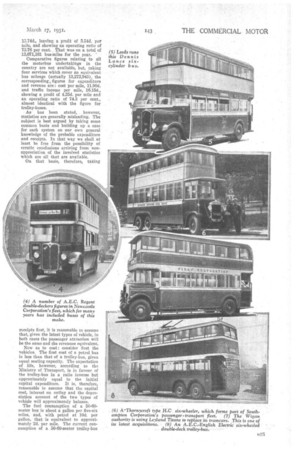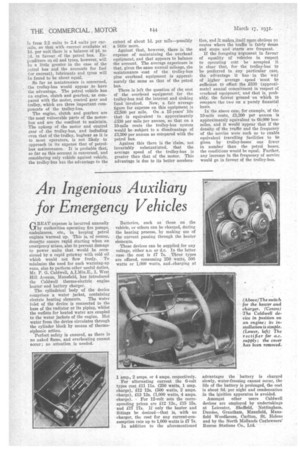MOTORBUSES or
Page 86

Page 87

Page 88

If you've noticed an error in this article please click here to report it so we can fix it.
TROLLEY-BUSES
IF, 50 years ago, the roads of this country had been as good as they are to-day and if motorbuses had then arrived at the state of excellence in which we now know them', would there bare been trams?
The answer to that question is so obvious that it need not even be set down here, but for the benefit of these. who are not well acquainted with the early history of the subject, it may be pointed out that the principal raison d'être of the coming into being of the tramline -was the poor state of the roads and the, excessive tractive effort needed to haul vehicles along them. The tramline provided a " road Asurface " which was smooth and easy to traverse.
Now comes the supplementary question. If there-hadbeen no trams, no overhead equipment available and no provision for' the electric current for the traction. of trams, would there have been trolley
buses? .
The answer to this question is not so obvious, but it is at least of interest to. note that nowhere in this country, has any trolley-bus system been put into operation except in replacement of tram services.
That is not, of course, conclusive proof that the trolley bus is not a practical and economical means for providing for urban passenger transport. A much more extensive examination of the pros and eons of the system, and comparison with other available methods of transport, are necessary before any conclusioncan be reached on that point.
There is a direct conflict of opinion amongst experienced users. Several towns are finding trolley-buses something of a white elephant on their hands. One important Yorkshire city has abandoned them. On the other hand, Wolverhampton finds them profitable, has an extensive mileage of trolley-bus routes in operation and would probably be willing
to extend them. Nottingham," whilst akreeing that trolley-buses are more expensive to work, nevertheless finds them profitablebe-. cause the inhabitants of that city prefer them to motorbuses.
Statistics are always dangerous. With a little. ingenuity it is possible, by the use of figures, to make good almost any case which can by the same elastic means be as easily demolished.
According to the latest Ministry of Transport report of trackless trolley undertakings there were, in the year 11129-30,. 168.76 miles of trolley-busroutes open for public transport The cost per mile averaged 10.20d., and the baffle income per vehicle-mile 11741, leaving % a profit of 3.54d. per mile, and showing an operating ratio of 73.76 per cent.. That was on a total of 13,671,161 bus-miles for the year.
Comparative figures relating to all the motorbus undertakings in the country are not available, but, taking four services which cover an equivalent bus mileage (actually 13,272,945), the corresponding,figures for expenditure and revenue are: cost per mile, 11.90d. and traffic income per mile, 16.15d., showing a profit of 4.25d. per mile and an operating ratio of 74.3 per cent., almost identical with the figure for trolley-buses.
As has been stated, however, statistics are generally misleading. The subject is best argued by taking some common basis and building up a case for each system on our own general knowledge of the probable expenditure and receipts. In that way we shall at least be free from the possibility of erratic conclusions arriving from nonappreciation of the involved statistics which are all that are available.
On that basis, therefore, taking receipts first, it is reasonable to a.ssume that, given the latest types of vehicle, in both cases the passenger attraction will be the same and the revenues equivalent.
Now as to cost: consider first the vehicles. The first cost of a petrol bus is less than that of a trolley-bus, given equal seating capacity. The expectation of life, however, according to the Ministry of Transport, is in favour of the trolley-bus in a ratio inverse but approximately equal to the initial capital expenditure. It is, therefore, reasonable to assume that the capital cost, interest on outlay and the depreciation account of the two types of vehicle will approximately balance.
The fuel consumption of a 50-60seater bus is about a gallon per five-six miles, and, with petrol at 10d. per gallon, that is equivalent to approximately 2d. per mile. The current consumption of a 50-60-seater trolley-bus
is from 2.2 units to 2.4 units per cariuile, so that with current available at id. per unit there is a balance of .id. to 1.;(1. in favour of the petrol bus. Expenditure on oil and tyres, however, will be a little greater in the case of the petrol bus and the accounts for fuel (or current), lubricants and tyres will be found to be about equal.
So far as maintenance is concerned, the trolley-bus would appear to have the advantage. The petrol vehicle has an engine, clutch and gearbox, as compared with the motor, control gear and trolley, which are three important components of the trolley-bus.
The engine, clutch and gearbox are the most vulnerable parts of the motorbus and are the costliest to maintain. The upkeep of the motor and control gear of the trolley-bus, and including even that of the trolley, bugbear as it is to most operators, is not likely to approach in its expense that of petrolbus maintenance. It is probable that, so far as this account is concerned, and considering only vehicle against vehicle, the trolley-bus has the advantage to the extent of about ld. per mile—possibly a little more.
Against that, however, there is the expense of maintaining the overhead equipment, and that appears to balance the account. The average experience is that, given the same annual mileage, the maintenance cost of the trolley-bus plus overhead equipment is approximately the same as that of the petrol bus.
There is left the question of the cost of the overhead equipment for the trolley-bus.and the interest and sinking fund involved. Now, a fair average figure for expense on this equipment is £2,500 per mile. On a 15-years' life that is equivalent to approximately £30 per mile per annum, so that on a 10-mile route the trolley-bus system would be subject to a disadvantage of £3,300 per annum as compared with the petrol bus.
Against this there is the claim, not invariably substantiated, that the average speed of the trolley-bus is greater than that of the motor. This advantage is due to its better accelera
tion, and it makes itself more obvious on routes where the traffic is fairly dense and stops and starts .are frequent.
If the foregoing argument in favour of equality of vehicles in respect to operating cost be accepted it is clear that, for the trolley-bus to be preferred in any particular case, the advantage it has in the way of higher average speed must be sufficient to offset the £330 (approiimate) annual commitment in respect of overhead equipment, and that is, probably, the fairest ground on which to compare thetwo on a purely financial basis. .
In the above case, for example, of the 10-mile route, £3,300 per annum is approximately equivalent• to 60,000 busmiles, and it would appear that if the density of the traffic and the frequency of the service were such as to enable equivalent travelling facilities to tie given by trolley-buses one fewer in number than the petrol buses, the conditions would be equal. Further, any increase in the frequency of service would go in favour of the trolley-bus.
























































































































































































